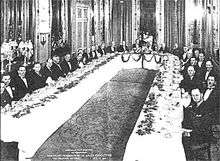Sales & Marketing Executives International
Sales & Marketing Executives International (SMEI) is a worldwide organization dedicated to ethical standards, continuing professional development, knowledge sharing, mentoring students and advancing free enterprise. Founded in 1935 in the U.S. as the National Federation of Sales Executives, the organization grew to become the largest in the world for sales and marketing managers by the late 1940s.

History
In the late 1880s, sales and marketing was not popularly considered to be an attractive career or a profession. But many in the business, seeing the need for professional recognition based on sound standards and ethical practices, created Sales Managers’ Clubs. First started in the 1880s in North America, they gradually spread throughout Europe, Australian, South American and the Pacific Rim.
From them emerged SMEI. In 1935, IBM Founder Thomas Watson, Sr.; Raymond Bill, founder of Sales and Marketing Management Magazine, and other visionaries invited the presidents of many Sales Managers’ Clubs to New York City to discuss forming a network of sales and marketing executives. The result was the National Federation of Sales Executives, the first of several names for SMEI.
The federation grew quickly, especially after World War II when member CEOs dedicated it to helping Europe and other war-battered areas rebuild their economies. By the late 1940s, the association included more than 40 countries and was the largest in the world for sales and marketing managers. In 1949 it became National Sales Executives (NSE)-International and in 1961 became SMEI.
Founding Principles
ALL of SMEI’s activities are guided by five founding principles, designed to strengthen principles and practice of the profession.
- Professional Standards and Identification: The improvement of the standards for professional selling, sales management and marketing, in order to establish sales and marketing as a recognized profession.
- Continuing Education: The planning and implementation of monthly meetings of the membership to enable members to keep up-to-date with changes in the marketplace and to grow as professionals. The planning and implementation of organized training programs for professional selling, sales management, and marketing.
- Sharing Knowledge: The establishment of discussion forums, for example, shirt sleeve seminars, and roundtable meetings which enable members to share sales and marketing experiences and knowledge.
- Assist Students: The establishment of programs to work with students at the high school and college levels to enable them to understand the excellent career opportunities in the sales and marketing profession. This objective ultimately led to the current SMEI sponsored programs with Distributive Education Clubs of America (DECA), and Pi Sigma Epsilon (PSE).
- Support the Free Enterprise System: In recognizing that sales and marketing is the energizing force that drives the competitive marketplace, SMEI has always been committed to supporting the free enterprise concept.
SMEI: Professional Certification Credentials

For the credibility of the profession, it is important to recognize marketing and sales professionals who have met and surpassed high standards of education, experience, knowledge, and ethical conduct. Sales & Marketing Executives International, Inc. (SMEI) has established sales certification and marketing certification programs for professionals to complete in order to be able to use its professional designations.
Certified Marketing Executive - CME®
- For marketing managers and top level executives.
Certified Sales Executive - CSE®
- For sales managers, company owners and top level executives.
SMEI Certified Professional Salesperson - SCPS™
- For sales representatives and professionals
SMEI Certified Professional Marketer - SCPM™ • For marketing representatives